Ngā tino mahi o te tau — Turnbull Library Arrangement & Description team highlights of 2020
The annual retrospective with observations and reflections from the Alexander Turnbull Library team who make our collections easier to find and use.
Contributors
Sascha Nolden (editor), with contributions by: Natasha Barrett, Catherine Bisley, Walter Cook, Dolores Hoy, Pamela Lovis, Merryn McAulay, Adam Melville, Sascha Nolden, Susan Skudder, Katrina Tamaira, Sheena Tawera, and Ariana Tikao.
Welcome to our 2020 wrap-up
Welcome to the 2020 edition of the Alexander Turnbull Library Arrangement & Description Team annual end-of-year blog.
Twelve members of the team take the opportunity to introduce themselves and reflect on examples of the work completed, selecting a personal highlight or simply an interesting task to showcase. This year has seen a number of staffing changes in the team, with positive growth in recent months resulting in new faces and skillsets being added. It has been a pleasure to collate and edit these contributions with the aim of preserving the individual voices.
Welcome to the world of A&D!
Dr Natasha Barrett, Research Librarian Digital Materials
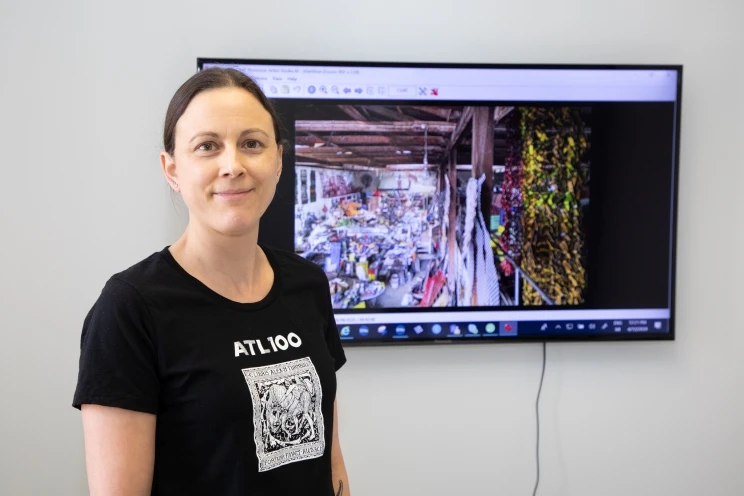
Natasha Barrett by Llewellyn Jones
Andy Spain's architectural photography
I’m new to the A&D team and started in October 2020, having previously worked at Auckland Libraries. As an amateur photographer, I was delighted to work on a donation of 39 digital photographs (PADL-001887) by Andy Spain, a photographer specialising in architectural photography. These richly textured and detailed photographs are exquisitely staged and lit. Taken between 2016 and 2020, they depict and document people (e.g. shopkeepers and artists) and building interiors (e.g. marae, hotels, and cinemas) from around New Zealand.
Like myself, Spain is British and based in Wellington. He studied Photography at the London College of Printing and moved to Aotearoa New Zealand in 2015. The photographs he donated to the Library speak about the immigrant response to living in this country, and specifically Wellington, in the case of his series titled ‘Cuba People’. As the name suggests, this series focuses on Cuba Street’s colourful businesses and the people who run them.
Conditions of the donation
As a professional who makes his living from photography, Spain provided conditions at the time of donation regarding the size of files to be made available online to library customers. These specifications differed from the usual JPG (digital image format containing compressed image data) access copies automatically generated and published online, and therefore required a different approach.
A new process also had to be established since this situation had not been encountered before. After speaking to my Digital Archivist colleagues, we liaised with the National Digital Heritage Archive (NDHA) team, who ensure long term access to and preservation of the Library’s digital collections. The NDHA came up with and implemented a solution that abided by Spain’s requirements, whilst still giving customers access to usable viewing copies.
This collection therefore stood out for me, not only for the beauty of the photographs but because it was a learning and problem-solving experience for myself and colleagues across the Library.
It is this cross collegiality and spirit of whanaungatanga or working together that makes the work we do possible, particularly given the many layered processes involved in making born digital collections available online.
Catherine Bisley, Librarian
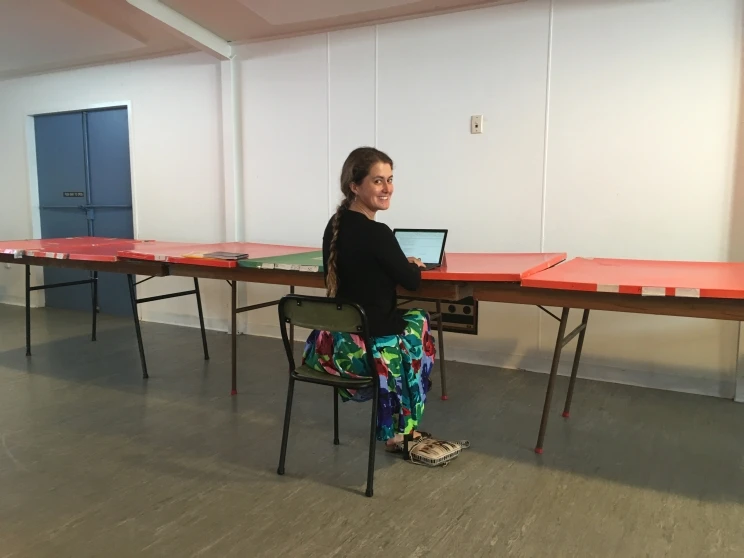
Catherine Bisley by Margaret Morris
John Scott architectural archive
In early March 2020, I took a trip to the Hawkes Bay to scope the architectural records of the late John Scott. My colleagues Margaret Morris (Senior Conservator, Works on Paper), John Sullivan (Curatorial Services Leader), and I joined three generations of Scott whānau and John Scott’s work itself in the Te Awanga Community Hall.
We set up the hall’s many trestle tables, laid out the 67 large, flat boxes in which Scott’s plans were stored (these originally held large-format photographic paper), and created a content listing.
Discussing the history of records with whanau
The records had an alpha numeric numbering system, with the boxes ranging from A1 to Y67. Box W55 was "Waitangi, Visitors Centre"; C17 was "Turangi Church" (the “C” here stands for Catholic Church, a regular commissioner of Scott’s buildings).
Some boxes contained multiple projects. The annotations on the box C10, for instance, read: "Coops. W, Cantwell, Campbell Dinks, Cooper, Community College … Caro, Curtis, Clayton, Christie Taupo, Clarke, Christie Shop."
Discussing Scott’s records, their creation, organisation, and storage with his whānau enabled me to better understand their history; this information is invaluable when it comes to processing a collection.
This trip was the last I went on before the COVID-19 lockdown. At home, working on improving our name indexing term dataset, I often cast my mind back to the Scott whānau’s manaakitanga (what a privilege it was to hear about Scott from his whānau over coffee and biscuits in a house that he himself had designed) and to the work we did in the Te Awanga Hall.
The collection was brought to Wellington by the Scott whānau in September and the processing, which is currently being planned, will begin in earnest in 2021.
Walter Cook, Volunteer Librarian
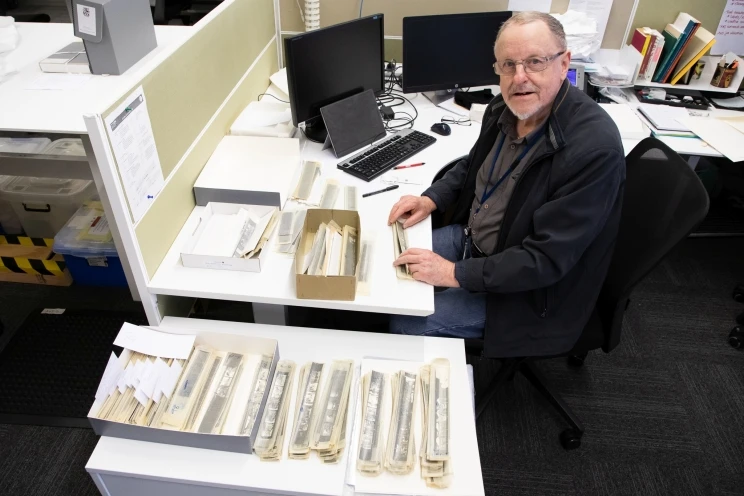
Walter Cook by Llewellyn Jones
Photo archive of Scouting New Zealand
I would be perfectly useless in ‘The Men’s Shed,’ so as an ageing retiree I thought ‘why not contribute in the line of work that I have been trained for?’ So I returned to my old job as a volunteer for two days a week doing five to six hours each day. I love it. I learn about things that I would otherwise know nothing about, such as my current project organising and cataloguing the photograph archive of Scouting New Zealand.
This arrived in the Turnbull Photograph Archive in 1997 — all 28 cartons. As a volunteer I can work on collections like this and contribute to clearing the backlog shelves in the stacks. In my youth I avoided Cubs and Scouts, and I could use my asthma and other allergies very effectively to get out of sports and the required ‘masculine’ activities that were pushed in the 1940s and 1950s, which I loathed.
The Scouting New Zealand archive covers the years circa 1946 to circa 1995. Over that time scouting seems to have shifted from the quasi-military organisation founded by Baden Powell, designed to prepare youth for future imperial wars and improving the moral and physical condition of ‘The Race,’ to an organisation that provided young people with various skills (like jet boating, flying, and abseiling) challenging them to be adventurous, creative and socially conscious.
By the 1970s disabled youth were integrated into scouting, and in the wake of the introduction of ‘Venturing’, males and females began to be merged into the movement. There seems to be no hint of the Guides in this collection, and Māori are almost entirely absent from scouting in New Zealand.
Jamborees
The most prominent feature of the collection are Jamborees, something I had never heard of before. I faced a tidal wave of records about them in this collection. National Jamborees were momentous events. Māori may have been absent, but for a national jamboree, contingents came from Niue, Samoa, Cook Islands, Tonga, Fiji, Vanuatu, Australia, the USA, Canada, Japan, Malaya, and Indonesia, and even Afghanistan in 1969.
Scouting and its activities in this country, given the exposure of our youth to other cultures, perhaps helped prepare young Pākehā for the cultural, social and political changes that were to come in the post-colonial era.
Dolores Hoy, Research Librarian, Digital Materials
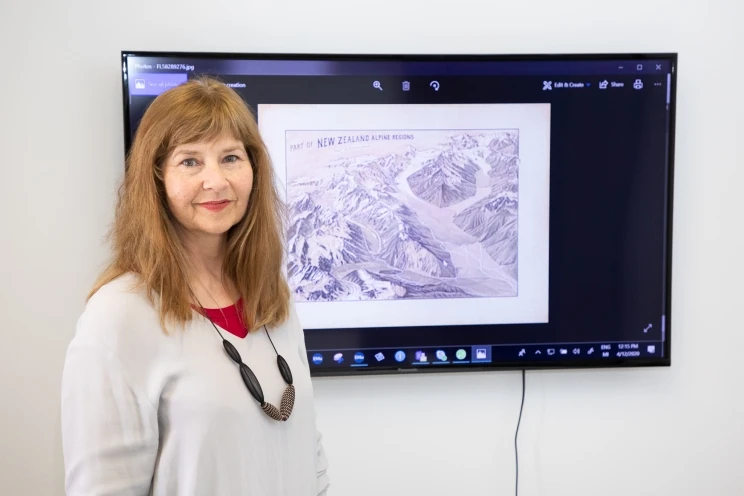
Dolores Hoy by Llewellyn Jones
Digital surrogates of New Zealand government agency maps
I have a strong memory from my university study days of a painting by Robert Ellis hanging in the university library. It was an interpretation of the cultural and political issues associated with cartography and depicted layers of maps made of the same piece of land, maps that were created by different people, in different times, and for different purposes. It sparked an interest in the stories associated with maps and map making; so, this year I was pleased to complete description of a special collection of digitised unpublished maps.
This collection is part of a multi-institutional collaboration, principally between the University of Auckland, National Library of New Zealand, and Land Information New Zealand (LINZ), to digitise the original maps and charts created by LINZ and its predecessors.
Documenting the changing geophysical and social landscape of Aotearoa
A number of the original maps and charts are unpublished and have since been added to the Alexander Turnbull Library cartographic collection. Some of these unpublished topographical and cadastral maps were the working tools of the New Zealand Geographic Board. They bear annotations added over time, often by unidentified hands, that tell us about the purpose behind the creation and use of the maps, for instance as evidence of land ownership or as aids for infrastructure planning.
They document the changing geophysical and social landscape of Aotearoa New Zealand and provide a unique source of information about our history and identity.
The project to digitise and describe both the unpublished and published maps has created a new resource for researchers and has improved public access to 140 years of New Zealand’s cartographic heritage.
The Alexander Turnbull Library collections related to this project are: University of Auckland and National Library of New Zealand Digital surrogates of New Zealand government agency maps, and New Zealand Geographic Board: Selection of maps of New Zealand.
The published maps digitised in the same project can be accessed on the catalogue of the National Library of New Zealand.
Pamela Lovis, Librarian
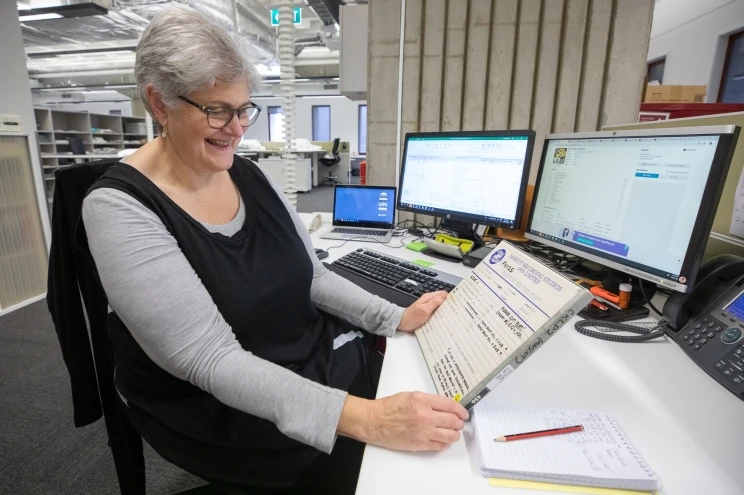
Pamela Lovis by Mark Beatty
Chris Knox’s rich collection
I’ve continued work on the Flying Nun Records collection this year, enhancing the records for a range of formats and from various donors.
In the middle of the year, back from lockdown, it was time to delve into Chris Knox’s rich collection. This includes solo recordings as well as his bands ‘The Enemy’, ‘Toy Love’ and ‘Tall Dwarfs’. At times I’ve felt like I’ve been living inside Chris’ head as I go through the creative album and track titles — such as ‘Polyfoto Duck Shaped Pain’, ‘Slugbucket’ and ‘Fifty Flavours of Glue’.
Mercifully legible handwriting
Sometimes the backs of the tape cases are works of art themselves. Track listings, durations, and recording information are detailed in Chris’ distinctive, tidy, mercifully legible handwriting, along with his occasional witty comments and illustrations.
And because it’s Christmas and has been a strange year I have to mention the ‘The Worst Noel’ recorded by ‘The Jessels’, which is Chris Knox, his partner Barbara and friends David and Hamish Kilgour who all lived in and near Jessel Street in Dunedin.
This eclectic, Christmas themed track was released as the B side by Flying Nun in 1982, while the A side features Bob the cat, aka ‘Bobzilla’, a monster cat who demolishes the neighbourhood. Maybe just what you need for Christmas this year?
Merryn McAulay, Librarian
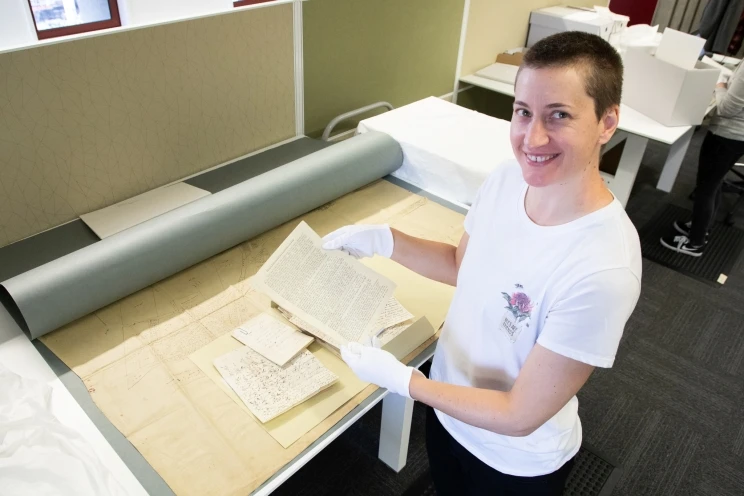
Merryn McAulay by Llewellyn Jones
Bibby family papers
A collection I enjoyed working on this year was not a newly acquired collection, but something the Library has had for roughly 40 years; the Bibby family papers collected by Edward Stuart Bibby.
Bibby was a family and local historian of the Waipawa and Ongaonga Districts in Central Hawke’s Bay where the Bibby family lived for many years, and in 1990 he donated his papers (along with an extensive photograph collection) to the Library.
Resources available at the time meant it had only been described at a collection level, the individual folders and items within the collection were not described, until now…
When a researcher was at the Library looking to access specific material from within the collection, I did some quick enhancements to add titles and dates to the folders. As I looked at this collection, I discovered it contained an absolute treasure trove and incredible variety of material, which, thanks to work done on the collection, is now easier for researchers to find and access.
Letter transcript
One thing that caught my attention was a transcript (perhaps typed by Edward Bibby) of an extract of a letter by Agnes V Glover written to Mary Glover Bibby (in New Zealand) about her experiences as part of the Suffragette movement in London. She discusses nursing people who had been on hunger strikes, taking part in the 1910 ‘Black Friday’ demonstration in London, experience with police, and her own changes in feelings and opinion over time. The extract ends with a note about suffrage:
"Isn’t it funny that one of the reasons we are not to have it is because the New Zealand women have it and you are so immoral, and this has increased since you were given the votes. It is sad you are all so bad!"
The full extract is located in this folder.
Adam Melville, Research Librarian, Digital Materials
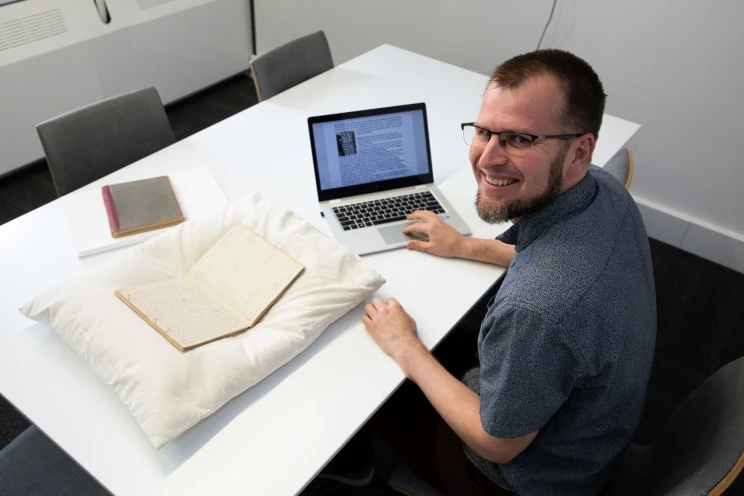
Adam Melville by Llewellyn Jones
Dunstan family papers
Having joined the A&D team in the final quarter of 2020, I am still very much finding my feet. Yet, I have already encountered several interesting collections. And in this travel-affected year, it was the collection relating to the Dunstan family holiday to New Zealand that stood out.
Edward Dunstan was a Methodist minister who, with his wife and two children, toured around New Zealand for several months during 1938-1939. Thankfully, Dunstan kept diaries of the holiday, allowing us insights into a time when international leisure travel was far less commonplace. Without the modern conveniences of online bookings, google maps, or GPS, the Dunstan family still managed to come halfway around the globe and tour the length and breadth of the country.
Even back in the 1930s, the sights of Rotorua, Milford Track, Waitomo Caves, and Franz Josef Glacier were drawcards for international visitors.
Bounty for Kea
But clearly the kea wasn’t in the running for Bird of the Year, with Dunstan writing:
“Both the Kea & deer have been recognized by the authorities as being in opposition to the interests of the country. Anyone who kills a Kea is rewarded with a fee of 7/6 [seven shillings and sixpence] & he has only to produce the upper beak of the bird as proof. It is said that this bird is the deadly enemy of sheep, — will stand on its back, pecking at its flesh, until it has an opening for an attack on its kidneys. The losses of farmers have been, in past days, heavy from this cause.”
Dunstan’s grandson transcribed the diaries and compiled them with photographs taken by his mother during the holiday, adding an introductory passage and footnotes.
This work — three generations in the making — is now available online.
Dr Sascha Nolden, Research Librarian
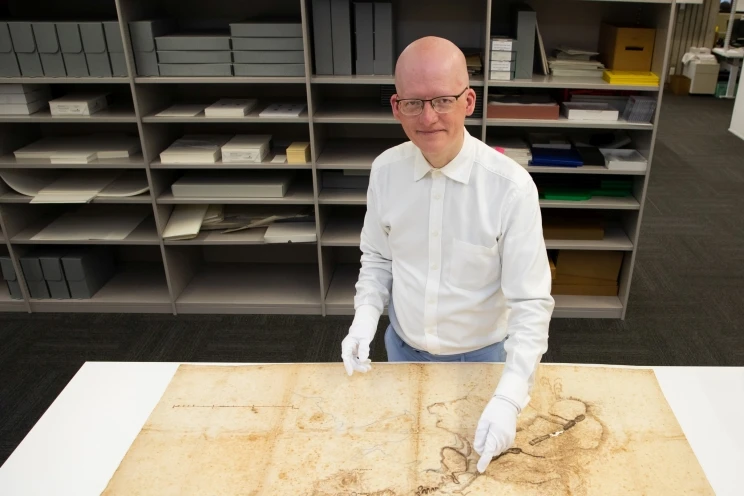
Sascha Nolden by Llewellyn Jones
Stephenson Percy Smith’s sketch map
One of the outstanding items added to the cartographic collection this year is Stephenson Percy Smith’s 1886 post-eruption sketch map of the Tarawera area, a sketch map of the area around Mount Tarawera created following the volcanic eruption of 1886.
Stephenson Percy Smith (1840-1922) led a government survey expedition into the area in 1886. This survey map was later copied on various occasions and formed the basis for the published map which accompanied the official report by Smith published in the appendices to the Journal of the House of Representatives for the year 1893.
Mount Tarawera and the eruption of 1886
The Library purchased the map at auction in late 2019 from a sale of items from the estate of the late Prof. Ron Keam who devoted a lifetime to researching and publishing on Mount Tarawera and the eruption of 1886. The map is of considerable research interest as it shows the completely altered and devastated landscape as recorded just months after the eruption. The physical environment was in a state of change with ongoing erosion and ponding — craters filling with water to create new, and newly delineated lakes and waterways. Bodies of water are coloured with a light blue wash, and three waterways labelled as “water course” and one as “Acid R[iver]”.
The map is also an important record of place names, and the topography of the land, with contour lines and heights recorded. Place names and locations labelled on the map include: Black Crater, Black Terrace Crater, Blue Lake [Lake Tikitapu], Echo Lake Crater, Green Lake [Lake Rotokakahi], Kaingaroa Plains, Maunga Kakaramea, Maungaongaonga, Pareheru, Te Hapeotoroa [Te Hape-o-Toroa Hill], Te Kumete [Ridge], The Pinnacles, Waikorua Earthquake Flat, Waiotapu, and annotated in pencil is Conical Hill.
The map arrived in the Library folded and in a fragile state. Since undergoing extensive conservation treatment, it is now stored rolled and is awaiting digitisation.
Dr Susan Skudder, Research Librarian
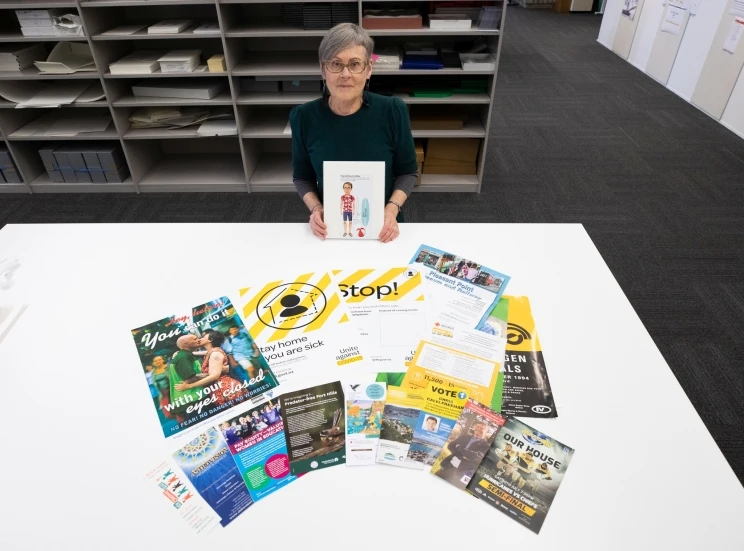
Susan Skudder by Llewellyn Jones
Ephemera related to COVID-19 and the general election
In 2018 and 2019 I spent half a day a week describing ephemera, under the guidance of Ephemera Curator Barbara Lyon. In early 2020, Barbara retired, and now the responsibility for describing all new accessions of ephemera falls to my colleague Merryn McAulay and myself.
Ephemera is defined as items that are not intended to last, such as advertising posters, programmes, leaflets, menus, tickets, greeting cards, and labels. The Library has an extensive collection of such material, contributed by staff and members of the public.
View the Ephemera collection page
This year has been an interesting year for ephemera, with the COVID-19 pandemic and lockdown, and the general election, both of which generated many leaflets, pamphlets, and other types of ephemera.
Our colleagues in the Digital Collecting team have been collecting and preserving online materials to do with COVID-19, and Merryn and I have been describing analogue material about COVID-19 donated to the Ephemera collection.
Ashley Bloomfield pop-out figure
A favourite of the team’s is a pop-out figure of Ashley Bloomfield at the beach, created as a marketing device by a real estate agent. It was challenging to store this pop-out, as the pieces literally kept popping out.
Our Conservation Technician Laura van Echten welded the bottom of a polypropylene sleeve normally used for housing photographs and, with an acid-free cardboard backing sheet also used for photographs, we managed to get the pop-out enclosed without any of the pieces falling out.
The sleeve is why I can hold the enclosure with bare hands, and is another example of the ingenuity of our Collection Care colleagues in devising ways of keeping physical collections safe.
It is always interesting describing ephemera, because there is such a variety of material, and there are always surprises (like the Bloomfield pop-out). We add Subject and Name indexing terms to facilitate access, and because I am a metadata geek, I really enjoy that part of the process, which can involve hunting down the right subject term to describe the material.
Merryn and I are trialling and writing up the new ephemera descriptive process so that by this time next year, any member of the A&D team can have the fun of describing the next accession of ephemera.
Katrina Tamaira, Kaipupuri Pūranga
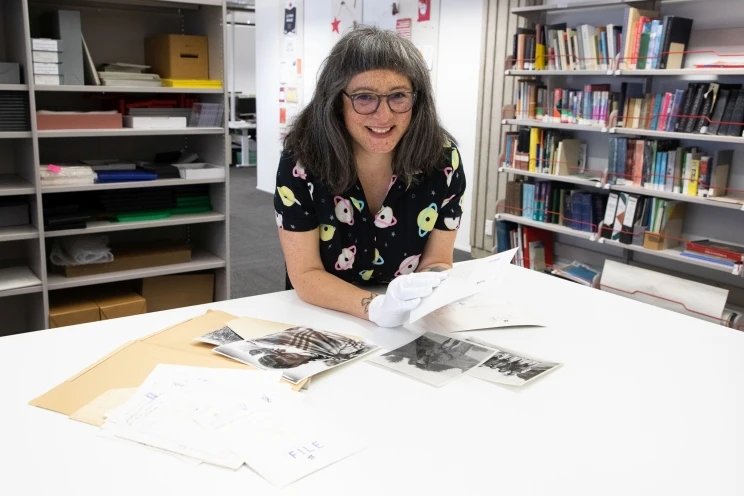
Katrina Tamaira by Llewellyn Jones
Whites Aviation file prints
As a newly seconded team member I’ve been sharpening my A&D pencil with Whites Aviation file prints. These were originally created as a reference tool for Whites Aviation staff, duplicate copies from the glass and film negatives – a kind of in-house library.
While most of the prints and negatives show views taken from the air, a few hundred were taken from the ground. Photographs of people, places, object, and events are, in theory, clearly identifiable.
When the original negatives were digitised by the Library, metadata from the negative sleeves were transcribed and added to the item record. However, like many other photographers of the 1900s, Whites Aviation often neglected to record the names of their subjects. At least 303 images taken from the ground depict Māori people, places or taonga with little or no metadata attached; unidentified people and unidentified taonga in unidentified places. This is where the file prints come in.
Analogue metadata like names and affiliations
Over time various people, including uri (descendants) of the people photographed, wrote brief descriptions on the reverse of many file prints. Uri might have noted down the subject’s name and who they were married to, others recorded marae names and tribal affiliations.
Most of this analogue metadata was not captured when the negatives were digitised, so it has been a real highlight to go back and enhance these descriptions - to put names to the Māori faces, and enable people like myself to connect with their whakapapa and whanaunga.
If you'd like to view these images, I have curated them in to DigitalNZ 'stories':
Sheena Tawera, Librarian
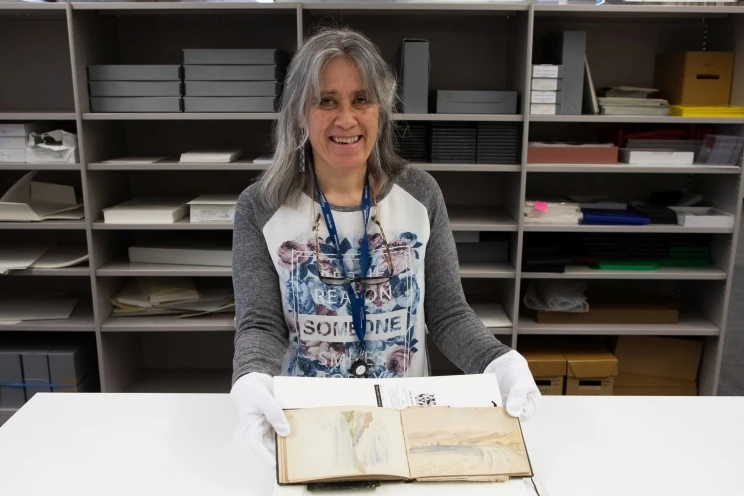
Sheena Tawera by Llewellyn Jones
Family papers of Mary Barkas and her father Frederick
I have enjoyed working on a range of projects and collections in 2020, including posting a karere (message) to Te Rōpū Whakahau’s website and arranging and describing Te Ao Hou-editor, Margaret Joy Parry’s collection of photographs.
One collection I found especially interesting was the family papers of Frederick Barkas and Mary Rushton Barkas, consisting of a transit box containing five manuscript folders, one sketchbook and two diaries. The collection comprises travel accounts, and day-to-day correspondence between Mary Barkas and her father Frederick, in the form of daily letters, diary entries, and sketchbook drawings.
Mary Barkas was the daughter of Frederick Barkas and Amy Parker. She achieved the position of Medical Superintendent at the Lawn Psychiatric Hospital in Lincoln, England, was a student of Carl Jung, and studied Chinese Philosophy. Her father Frederick Barkas worked at the Canterbury College of Agriculture and the New Zealand Loan and Mercantile Agency Company, until his retirement in 1919.
Correspondence, letters, and accounts between father and daughter
The correspondence, letters, and accounts between father and daughter are mostly written during Frederick’s retirement years in Timaru in the 1930s. Of interest is a 55-page typed letter describing Frederick’s three-month tour of the South Island between January and March 1932, including photographs of the people and places he visited; and a typescript entitled “The Story of a New Zealand Girl” in which he chronicles Mary’s travel’s around Europe in 1904.
Also of note are Mary’s daily diary entries written in 1944 recording her reflections, reviews, and critiques on philosophical texts she had enjoyed reading.
The collection will be of interest to historians looking into first-hand accounts of travel experiences within New Zealand during the 1930s, and those who are researching the social climate of early 20th-century Europe through the written recollections of a young, New Zealand female professional. Furthermore, the travelogues are timely and relevant, given New Zealanders are currently vacationing locally ‘in their own backyard’ due to Covid-19 restrictions on international travel.
Ariana Tikao, Research Librarian, Māori
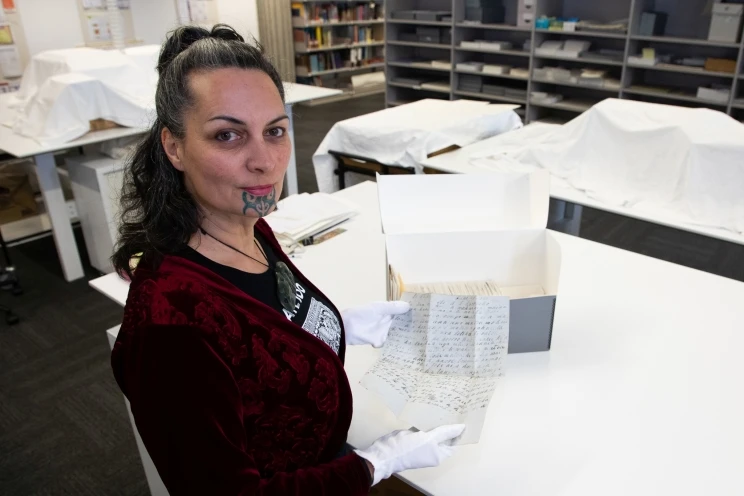
Ariana Tikao by Llewellyn Jones
Letters to William Colenso by Ngāti Kahungunu ancestors
The highlight of my A&D year is a special collection of over 200 letters written in te reo Māori from (mostly) Ngāti Kahungunu ancestors, written to the missionary William Colenso while he was based at the Waitangi Mission Station in the Heretaunga/Hawke’s Bay Region. They mostly date from the 1840s to 1850s, and many relate to religion, health, land loss, family bereavements, and issues such as theft and infidelity. The letters are part of the Christopher Parr collection which was purchased by the Library in 2019.
The letter I am holding is one of the last letters in the collection. The letters were written at a time before a consistent orthography existed for te reo Māori, and so spelling and word spacings are irregular. This one however, was relatively easy to read and understand, partly due to its larger size.
It was written by Peniamini Kopuawi on 23 June 1850. Peniamini (Māori for Benjamin) begins with an acknowledgement of a misfortune that has befallen Colenso:
E tā tēnā rā koe te wakaekea mai nā e ngā hau kino o te ao. E tā, tēnei kua tae mai, o rongo mate ki a mātou, heoi tangi ana anō mātou mōhou”.
It then turns to the main kaupapa of the letter, relating to the theft of money by a Pākehā called Tanara (Donald), who allegedly stole Manaia’s payments that may have come from the sale of their land. They tried to retrieve this money, but Tanara refused, and so Peniamini and others stole some of his property including a saddle, bridles, and ropes in retribution. It was weighing heavy on Peniamini’s heart, that he had stolen these items, and he was concerned about how others in his community perceived him after what he had done. He quotes biblical passages from Matthew and says that Kemara tried to make him feel better about what he had done.
To me, this letter illustrates a cultural clash at a time of great upheaval. Within the traditional system of muru, it would have been justified to have taken goods in exchange for an earlier transgression by Tanara. It must have been a difficult time for Māori tīpuna, grappling with new morals that came with Christianity, which did not match Māori cultural norms.
These letters are going to be digitised so are not yet available to order or view, but until then, their records are available by navigating to the record of the box they are housed in.
Letterlocking
Most of the letters are folded and some still have remnants of wax seals that were used to keep the letter shut. They were not put into envelopes, but sealed along the edge of the letter itself. The study of letters like this is called letterlocking.
There are many aspects of this collection of letters that hold cultural and research value, including the language (te reo Māori), the relationships (between Colenso and the various tīpuna mentioned in the letters), place names, and historical contexts, but also the evidence of the physical elements which can be gleaned from the paper, writing, and very folds of each item, that can soon be unlocked for future generations.
Wonderful to have this annual insight into the work of the Turnbull's A&D team and some of the hundreds of collections they make accessible to researchers every year. Thank you all for your work.